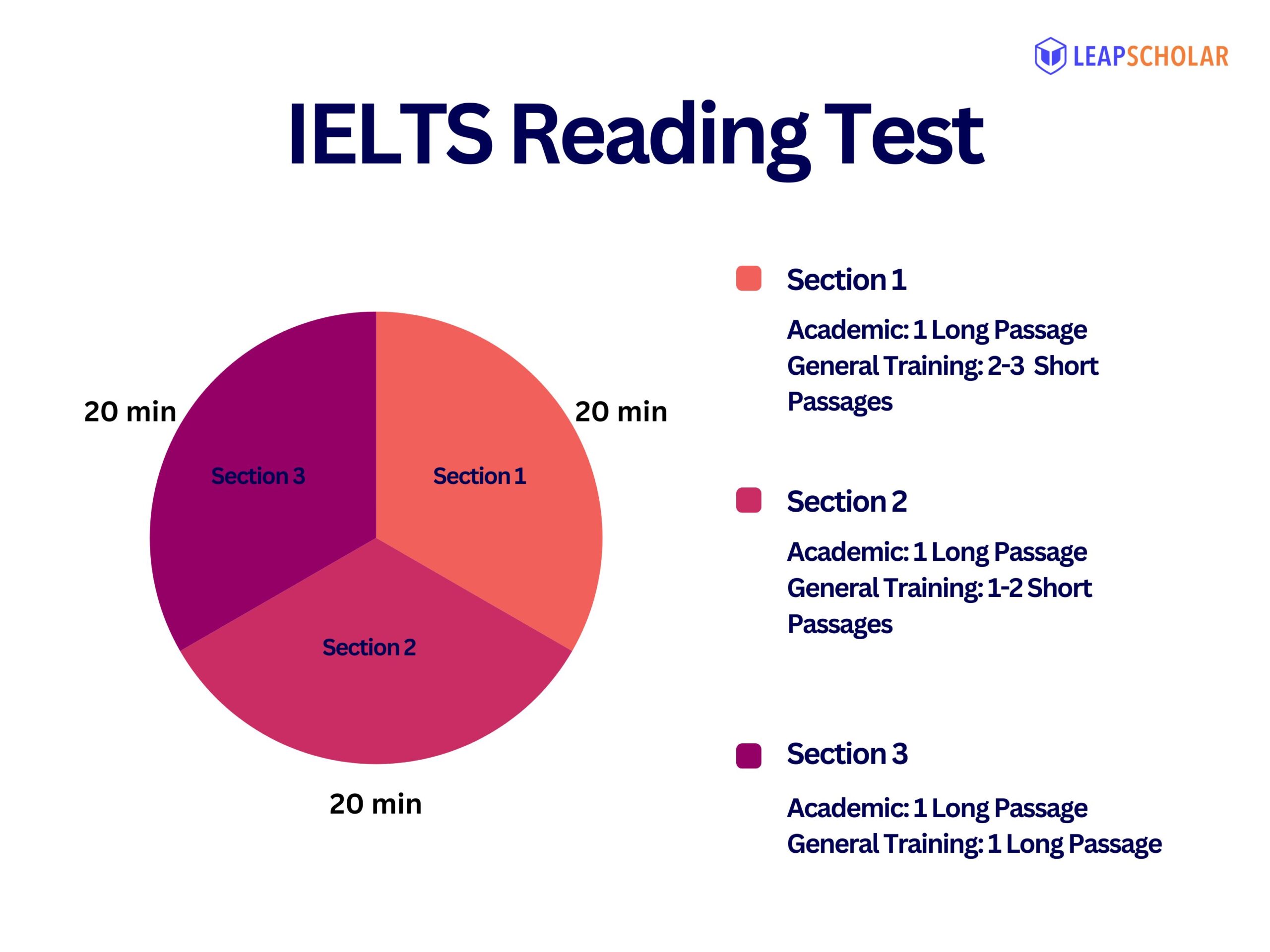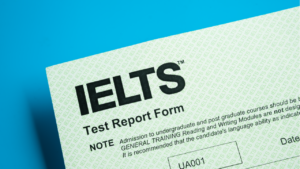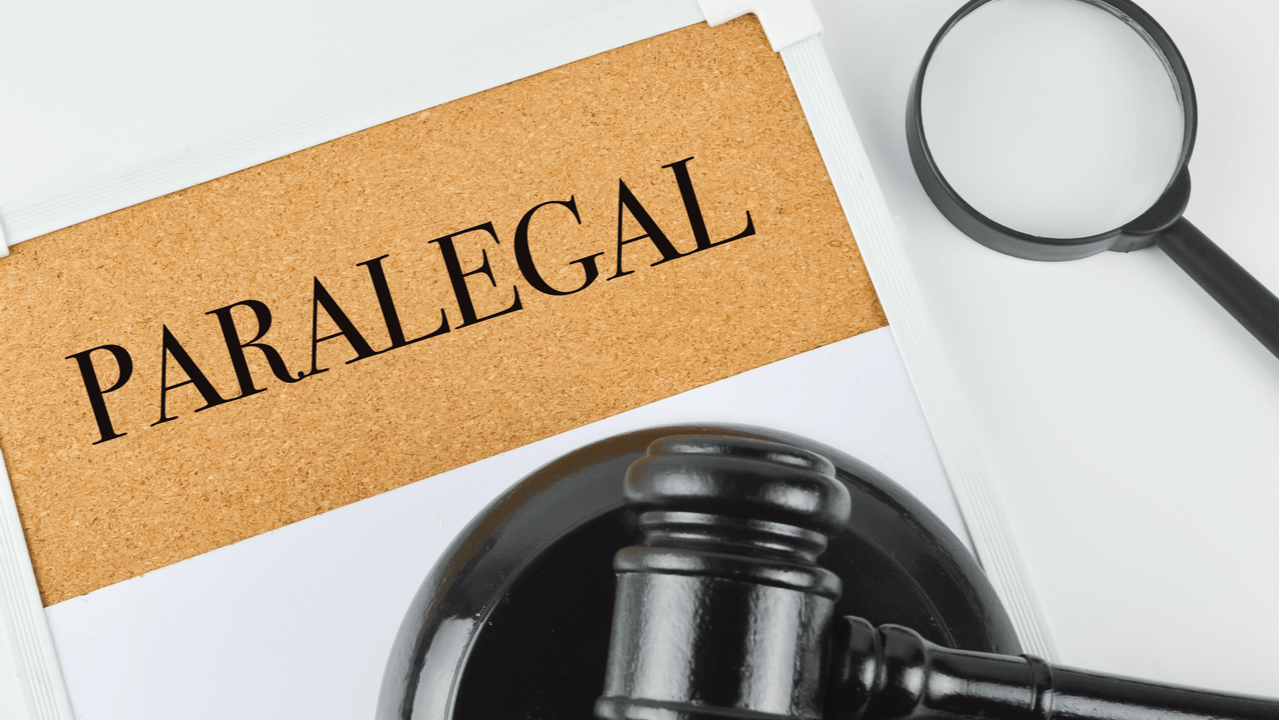The IELTS, or International English Language Testing System, is one of the most popular language proficiency tests across the world. The IELTS test is essential if you plan to study or work abroad.
It assesses your English language capacities. It checks how fast you can read and understand practical information, follow written directions, and pay attention to details in everyday situations.
The IELTS Reading test is one of the four modules of the IELTS test. It consists of 40 questions.
The passages in the test are extracted from brochures, newspapers, guidelines, or company handbooks.
IELTS Reading Test Overview:
| Total Duration | 60 minutes |
| Number of sections | 3 |
| Number of questions | 40 |
| Marking | Each correct answer receives one mark |
| Band Score Range | 0-9 |
The given IELTS Reading Passage Could Urban Engineers Learn from Dance is followed by the given question types:
- Matching Features
- Sentence Completion
- Short-answer Questions
Try practising with the Could Urban Engineers Learn from Dance Reading Passage to improve your reading, language, and vocabulary skills for the IELTS test. Check out the blog for the answer key and a detailed explanation with references for the given question sets.
Leap Advantage Virtual Spot Offer Event on May 10th 2024

Last call to secure your spot for Masters in STEM Program in the US for Fall ’24 exclusively for graduates and above.
Leap Advantage Virtual Spot Offer Event on May 10th 2024
Last call to secure your spot for Masters in STEM Program in the US for Fall ’24 exclusively for graduates and above.

About Passage: Could Urban Engineers Learn from Dance
Before moving to the IELTS Reading passage provided below, let us look at the peculiarities of the text.
Check out why the reading passage about how urban engineers could learn from dance is important:
- The Could Urban Engineers Learn from Dance is part of the IELTS reading test. It’s structured to see how good you are at focusing, managing time, reading fast, and understanding what you read.
- The test assesses how well you handle information and use what you know.
- Practising with this passage is helpful because it gets you used to different question types and makes you better at picking the correct answers.
- Doing this exercise is good because it shows where you’re doing well and where you can get better. The answers with explanations give you a clear idea of how you’re preparing.
Also Read: IELTS Reading Tips & Tricks 2024
Sample Passage: Could Urban Engineers Learn From Dance
Read the text given and try answering the following questions. Once done, check your answers against the given answer key.
Could Urban Engineers Learn From Dance?
A. The way we move around cities has a significant influence on their sustainability. Transportation is projected to account for 30% of energy consumption in most of the world’s most industrialized countries; therefore, reducing the demand for energy-consuming automobiles is critical for reducing mobility’s environmental effect. However, as more people relocate to cities, it is critical to consider alternate forms of sustainable mobility. The modes of transportation we use have an impact on our physical and mental health, our social life, our access to jobs and culture, and the air we breathe. Engineers are entrusted with transforming how we travel around cities through urban design, but the engineering profession continues to work on the assumptions that led to the establishment of the energy-consuming transportation systems we presently have: the emphasis on efficiency, speed, and quantitative data. We need drastic reforms to make city travel healthier, more fun, and less harmful to the environment.
B. Some of the solutions may be found in dance. That is not to say that everyone should dance their way to work, no matter how healthy and joyful it makes us; rather, the methodologies used by choreographers to experiment with and create movement in dance might give engineers tools to spark new ideas in city-making. Richard Sennett, a prominent urbanist and sociologist who has revolutionized notions about how cities are built, contends that since the advent of the architectural plan, there has been a split between mind and body in urban architecture.
C. Building designs are now conceived and stored in media technologies that insulate the developer from the physical and social realities they’re creating, whereas medieval builders extemporized and acclimated construction through intimate knowledge of accoutrements and particular experience of point conditions. While these new technologies’ design techniques are critical for handling the technological complexity of the contemporary city, they have the disadvantage of simplifying reality in the process.
D. Sennett, for example, highlights the Peachtree Center in Atlanta, USA, a development characteristic of the 1970s modernist approach to urban planning. Peachtree designed a grid of streets and skyscrapers to serve as Atlanta’s new pedestrian-friendly downtown. According to Sennett, this failed because its creators placed too much trust in computer-aided design to predict how it would work. They failed to consider that purpose-erected road cafés couldn’t operate in the hot sun without the defensive canopies common in aged structures and would rather bear energy-ferocious air exertion or that its massive car park would feel so unwelcoming that people would be discouraged from getting out of their cars. When what appears to be totally predictable and controllable on screen is transferred into reality, the outcomes are unanticipated.
E. The equivalent exists in the field of transportation engineering, where prototypes are used to forecast and transform the ways individuals move around metropolitan areas. Again, these models are vital, but they are based on certain world views that prioritize efficiency and safety over other aspects of city life. In practice, designs that look rational in models appear counter-intuitive to their consumers. Guard rails, for example, will be recognizable to anybody who has attempted to cross a British road. They were an engineering solution to pedestrian safety based on models that prioritize traffic movement. On major roads, they typically direct people to specific crossing points and restrict their progress by separating the crossing into two – one for each highway. As a result, crossings feel longer, imposing psychological obstacles that disproportionately affect the least mobile and pushing others to conduct unsafe crossings to avoid the guard rails. These barriers not only make it more difficult to cross the street; they also divide communities and reduce options for healthy transportation. As a result, many are being removed, generating inconvenience, expense, and waste.
F. There could have been a better answer if their designers had been given the ability to think with their bodies, like dancers, and envisage how these boundaries would feel. Engineering will need to gain a greater knowledge of why people move in specific ways and how this mobility affects them in order to bring about substantial changes in the ways we utilize our cities. Choreography may not appear to be an apparent solution to this situation. Nonetheless, it shares with engineering the goal of developing movement patterns under spatial constraints. It is an art form that was created almost completely by experimenting with concepts on the body and receiving immediate feedback on how the outcomes felt. Choreographers have a thorough awareness of the psychological, artistic, and physical ramifications of various movements.
G. Cognitive scientist David Kirsh observed choreographer Wayne McGregor and detailed how he “thinks with the body.” Kirsh contends that by utilizing the body to model outcomes, McGregor is able to envisage solutions that would not be conceivable with solely abstract reasoning. This type of physical knowledge is appreciated in many areas of expertise but has no place in formal engineering design procedures at the moment. Transport engineers might improvise design concepts and get rapid feedback about how they would function based on their own expertise, or they could model designs at full size in the same manner that choreographers experiment with groups of dancers. Above all, students may learn to design for both emotional and utilitarian benefits.
Also Read: Types of IELTS Tests
Crack IELTS Exam in first attempt

Attend Leap’s free masterclass to get tips, tricks and advance strategies to crack IELTS exam in first attempt
Crack IELTS Exam in first attempt
Attend Leap’s free masterclass to get tips, tricks and advance strategies to crack IELTS exam in first attempt

Sample Questions: Could Urban Engineers Learn From Dance
Let’s try the Could Urban Engineers Learn from Dance Reading question.
Questions 1-6
Reading Passage has seven paragraphs A-G.
Which paragraph contains the following information?
Write the correct letter, A-G, in boxes 1-6 on your answer sheet.
1. a reference to an unanticipated problem caused by neglecting the climate
2. a reference to how transportation affects people’s lives
3. why certain people-helping initiatives are being reversed
4. a reference to an enticing technique of employing dance that the author does not advocate
5. statement of a goal shared by dance and engineering
6. a comparison between ancient and modern methods of construction
1. – _____
2. – _____
3. – _____
4. – _____
5. – _____
6. – _____
Could Urban Engineers Learn from Dance Reading Answers 1-6
Question Type: Matching Features
1. D
Reference
Paragraph D: They failed to consider that purpose-erected road cafés couldn’t operate in the hot sun without the defensive canopies common in aged structures and would rather bear energy-ferocious air exertion or that its massive car park would feel so unwelcoming that people would be discouraged from getting out of their cars.
Explanation
The paragraph explains that the engineers failed to consider that purpose-erected road cafés cannot operate in the hot sun without the help of defensive canopies. It further mentions that it would rather bear energy-ferocious air exertion or that its massive car park would feel so unwelcoming that people would be discouraged from getting out of their cars.
2. A
Reference
Paragraph A: The modes of transportation we use have an impact on our physical and mental health, our social life, our access to jobs and culture, and the air we breathe.
Explanation
The paragraph mentions that the different modes of transportation impact our physical and mental health, our social life, our access to jobs and culture, and the air we breathe.
3. E
Reference
Paragraph E: The equivalent exists in the field of transportation engineering, where prototypes are used to forecast and transform the ways individuals move around metropolitan areas. Again, these models are vital, but they are based on certain world views that prioritize efficiency and safety over other aspects of city life.
Explanation
The paragraph specifies that the equivalent exists in the field of transportation engineering, where prototypes are used to forecast and transform how individuals move around metropolitan areas. It further explains that these models are vital but based on particular world views prioritising efficiency and safety over other aspects of city life.
4. B
Reference
Paragraph B: Some of the solutions may be found in dance. That is not to say that everyone should dance their way to work, no matter how healthy and joyful it makes us; rather, the methodologies used by choreographers to experiment with and create movement in dance might give engineers tools to spark new ideas in city-making.
Explanation
The paragraph specifies that some of the solutions may be found in dance. It also mentions that this is not to say that everyone should dance their way to work, no matter how healthy and joyful it makes us. It further states that the methodologies used by choreographers to experiment with and create movement in dance might give engineers tools to spark new ideas in city-making.
5. F
Reference
Paragraph F: Engineering will need to gain a greater knowledge of why people move in specific ways and how this mobility affects them in order to bring about substantial changes in the ways we utilize our cities. Nonetheless, it shares with engineering the goal of developing movement patterns under spatial constraints. It is an art form that was created almost completely by experimenting with concepts on the body and receiving immediate feedback on how the outcomes felt.
Explanation
The paragraph states that engineers must gain an excellent knowledge of why people move in specific ways. It further mentions that mobility affects them to change how we utilise our cities substantially. The paragraph explains that dance shares with engineering the goal of developing movement patterns under spatial constraints. It implies that dance is an art form created almost entirely by experimenting with concepts on the body and receiving immediate feedback on how the outcomes felt.
6. C
Reference
Paragraph C: Building designs are now conceived and stored in media technologies that insulate the developer from the physical and social realities they’re creating, whereas medieval builders extemporized and acclimated construction through intimate knowledge of accoutrements and particular experience of point conditions.
Explanation
The paragraph explains that the building designs are now conceived and stored in media technologies, insulating the developer from the physical and social realities they create. It also states that the medieval builders extemporised and acclimated construction through intimate knowledge of equipment and particular experience of point conditions.
Also Read: IELTS Test Online
Questions 7-10
Complete the summary below.
Choose ONE WORD ONLY from the passage for each answer.
Write your answers in boxes 7-10 on your answer sheet.
Guard rails were installed on British highways to improve the 7. _______________ of pedestrians while ensuring that the passage of 8. _______________ is not impeded. Pedestrians are directed to access locations and urged to cross one 9. ______________ at a time. Unintended consequences include psychological difficulty in crossing the street, particularly for less 10. ________________ people.
Also Refer: Practice Speaking & Pronunciation For IELTS
Could Urban Engineers Learn from Dance Reading Answers 7-10
Question Type: Sentence Completion
7. Safety
Reference
Paragraph E: Guard rails, for example, will be recognizable to anybody who has attempted to cross a British road. They were an engineering solution to pedestrian safety based on models that prioritize traffic movement.
Explanation
The paragraph explains that the guard rails, for example, will be recognisable to anyone attempting to cross a British road. It also mentions that they were an engineering solution to pedestrian safety based on models that prioritise traffic movement.
8. Traffic
Reference
Paragraph E: They were an engineering solution to pedestrian safety based on models that prioritize traffic movement.
Explanation
The paragraph explains that they were an engineering solution to pedestrian safety based on models that prioritise traffic movement.
9. Highway
Reference
Paragraph E: On major roads, they typically direct people to specific crossing points and restrict their progress by separating the crossing into two – one for each highway.
Explanation
The paragraph explains that on major roads, they typically direct people to specific crossing points and restrict their progress by separating the crossing into two – one for each highway.
10. Mobile
Reference
Paragraph E: As a result, crossings feel longer, imposing psychological obstacles that disproportionately affect the least mobile and pushing others to conduct unsafe crossings to avoid the guard rails.
Explanation
The paragraph states that the crossings feel longer, imposing psychological obstacles that disproportionately affect the least mobile and pushing others to conduct unsafe crossings to avoid the guard rails.
Try: IELTS Speaking Questions with Answers
Questions 11-13
Answer the questions below.
Choose ONE WORD ONLY from the passage for each answer.
11. Which form of barrier is introduced, causing disproportionate injury to the least mobile and encouraging others to participate in risky crossings to avoid the guard rails?
12. What do the guard rails separate for healthy transportation?
13. Who is well-versed in the psychological, artistic, and physical repercussions of numerous movements?
Try Now: IELTS General Writing Task 1
Could Urban Engineers Learn from Dance Reading Answers 11-13
Question Type: Short Answer Questions
11. Psychological
Reference
Paragraph E: As a result, crossings feel longer, imposing psychological obstacles that disproportionately affect the least mobile and pushing others to conduct unsafe crossings to avoid the guard rails.
Explanation
The paragraph states that the crossings feel longer, imposing psychological obstacles that disproportionately affect the least mobile and pushing others to conduct unsafe crossings to avoid the guard rails.
12. Communities
Reference
Paragraph E: These barriers not only make it more difficult to cross the street; they also divide communities and reduce options for healthy transportation.
Explanation
The paragraph explains that these barriers make it more challenging to cross the street. It also mentions that they divide communities and reduce options for healthy transportation.
13. Choreographers
Reference
Paragraph F: Choreographers have a thorough awareness of the psychological, artistic, and physical ramifications of various movements.
Explanation
The paragraph explains that the choreographers are thoroughly aware of various movements’ psychological, artistic, and physical ramifications.
Also Read: IELTS Listening Practice Test 2024
Tips & Tricks for the IELTS Reading Test

Let’s explore some tips and tricks for the IELTS Reading Test to make your exam easier and to help you score better.
1. Preview the Questions: Before reading the passage, take a quick look at the questions. It helps you know what to look for while reading.
2. Underline/Focus Keywords: While reading, underline essential words in the questions and passages. It helps you stay focused on what’s necessary.
3. Manage Your Time: Keep an eye on the clock. Spend 20 minutes on each section to ensure enough time for all three parts.
4. Skim and Scan: Quickly read through the passage to get the main idea (skim), then go back to find specific details (scan) when answering questions.
5. Practice Regularly: Improve your reading skills by practising regularly with different types of texts. It helps you become familiar with various topics and question formats.
6. Guess if Unsure: If you’re not sure about an answer, make an educated guess. There are no penalties for wrong answers, so it’s better to try than to leave it blank.
7. Read Carefully: Pay close attention to the details in the passage. Read each question carefully to avoid mistakes.
8. Use Headings and Subheadings: Headings and subheadings in the passage can guide you to the relevant information. They act like road signs, pointing you in the right direction.
9. Watch for Synonyms: Sometimes, the words in the questions may differ from those in the passage. Look for synonyms (words with similar meanings) to find the correct answers.
10. Stay Calm and Focused: During the test, stay calm and focused. If you find a question challenging, move on to the next one and return later. Don’t let one question stress you out.
Also Read:
- IELTS Writing Task: Best Tips To Begin With
- IELTS Speaking Band 9 – Tips And Tricks
- How to Prepare For IELTS at Home
- IELTS Writing Samples 2024
Conclusion
In conclusion, approaching the IELTS Reading Test with confidence and effective strategies is critical to your success.
Remember to manage your time wisely, allocating roughly 20 minutes to each section. Utilise the question paper for notes, but ensure your final answers are on the answer sheet. Don’t worry about negative marks; take educated guesses if needed. Spelling matters are penalised, so double-check your answers for accuracy.
Remember that passages vary in difficulty, so stay focused and adapt your reading speed accordingly. Mistakes are part of the learning process, so don’t be discouraged. Stay positive, practice regularly, and be well-prepared for the IELTS Reading Test.
Additionally, seek guidance from experienced individuals or IELTS counselling services. These sessions can provide valuable insights, tips, and practice materials. It’s essential to attend counselling with an open mind, actively participate, and clarify any doubts you may have.
Best of luck on your journey to achieving your desired scores!
For more information, consult Leap Scholar Counsellors today.
Frequently Asked Questions
-
Q. Is the IELTS Reading Test important?
A. The Reading section of the International English Language Testing System (IELTS) exam is one of the most essential parts. Your ability to comprehend written texts, including the primary concepts and the evidence that supports them, will be evaluated throughout the course. It assesses your cognitive skills to determine how effectively you understand what you are reading and how well you can locate useful information in various sorts of writing, such as emails, articles, and advertisements.
-
Q. What are the total sections that make up the IELTS Reading test?
A. The IELTS Reading test has three sections, each consisting of a distinct piece of writing. The longer you read from part one to section three, the more complex these words get. Take a quick look at the questions to understand what to anticipate. You can read more quickly and effectively using this. It will help you in improving your overall performance and the band score.
-
Q. What are the types of questions in the IELTS Reading test?
A. There are various questions on the IELTS Reading test, including questions requiring you to complete sentences, tables, and other material. As a result of the fact that each question requires a distinct approach, you need to be familiar with how to respond to each one before the test.Reach out to Leap’s IELTS Experts for proper task-wise training.
-
Q. How long does it take to finish the reading portion of the IELTS exam?
A. Reading is the portion of the IELTS exam that takes one hour to complete. With thirteen to fifteen questions, each section can be completed in around twenty minutes. You must pay great attention to the headings and subheadings included in the passage. They can provide you with advice that will assist you in determining the material and structure.
-
Q. Can I write directly on the paper when taking the IELTS Reading test?
A. Yes, you can write directly on the question booklet if you are taking an offline test. To provide accurate responses to the questions, you can write things down, highlight them, or circle them. You should read the sentence further if you cannot comprehend the word’s meaning. This will assist you in understanding the primary idea.
-
Q. Does the IELTS Reading test have a negative marking?
A. Providing incorrect responses on the IELTS Reading test will not negatively affect you. Try to guess an answer rather than leaving it blank because there is a possibility that you will get it right. If you get it correct, you will receive additional points.
-
Q. Can I use a pencil rather than a pen when taking the IELTS Reading test?
A. Yes, the reading portion of the IELTS exam can be completed with either a pencil or a pen. If you need to make adjustments, the most effective method for completing activities, such as filling in blanks or matching data, is to use a pencil. Searching for keywords and their synonyms (sentences or phrases that have been altered yet still convey the same meaning) is essential.
-
Q. When you take the IELTS Reading test, will all the passages be relevant to academics?
A. Contrary to popular belief, the IELTS Reading test is not merely a measure of general knowledge. Passages in the general test are typically based on general topics, and passages for the academic test are based on academic subjects. In addition, you will be required to read scientific materials, snippets from magazines or books, and news articles to pique the public’s curiosity.
-
Q. Can I review the texts again while taking the IELTS Reading test?
A. Yes, you can review the material you have read while responding to the questions on the test. You will be provided with the passage and its questions to facilitate a speedy search for the answers you are required to answer. If you are unclear about the answers, you should cross out the less appropriate options. This way, you have a better chance of selecting the appropriate option.
-
Q. Is it necessary for me to read the entire passage to pass the IELTS Reading test?
A. It is recommended to read the entire passage to ensure proper coverage of information. If you are in a hurry, reading the entire chapter can take time. You can scan the passage and gather the information you need to answer the questions by concentrating on what you need to know and skimming it. It is an excellent technique to speed through the passage. But make sure you don’t overlook the specifics.
-
Q. Can I take notes while reading for the IELTS Reading test?
A. Yes, you are permitted to take notes while reading the passages on the IELTS Reading test. You can make use of these notes to assist you in remembering significant facts, the primary points of an argument, or anything else that will help you provide an excellent response.
-
Q. What are the guidelines for using my language while responding to questions on the IELTS Reading test?
A. In the Reading section of the IELTS exam, you can respond to questions using your own words. Nevertheless, it is of the utmost importance that your response precisely corresponds to the information presented in the text. You can demonstrate that you understand the item by adjusting and outlining it. The more you practise taking the test, the better you will become at it. You can become accustomed to the various types of questions through practice tests.







